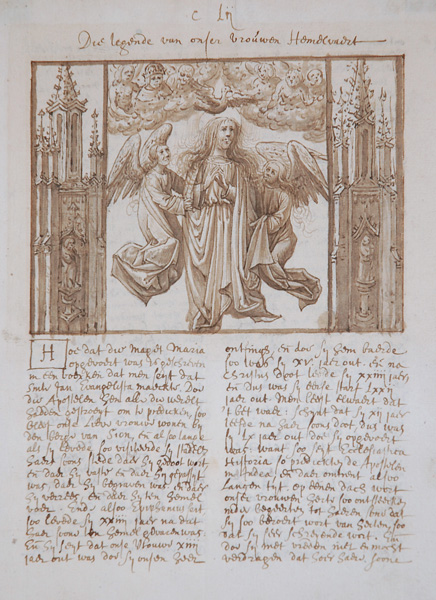Click for BBB rating See our Privacy Policy
Welcome to Spaightwood Galleries, Inc.
120 Main Street, Upton MA 01568-6193
For more information or to purchase, please call 1-800-809-3343 or email us at spaightwood@gmail.com
You can follow us on Facebook and Twitter!
We blog regularly on Facebook and announce special events and special sales on both sites.
Last updated: 6/23/2019
Home / Gallery Tour 1 / Master Drawings and Prints / Gallery Tour 2
Gallery News
Biblical Subjects / Mythological Subjects / Allegorical Subjects / Historical Subjects
Adam and Eve / Noah / Lot and his Daughters / Joseph / Samson / Jephthah and his Daughter
David / Judith / Esther / Susanna and the Elders
De Vos Old Testament Women 1 / De Vos Old Testament Women 2 / De Vos New Testament Women
The Virgin Mary / Mary Magdalen / The Woman taken in adultery
Maundy Thursday / The Crucifixion / The Lamentation / The Resurrection
Although Mary Magdalen has a relatively small role in the canonical Gospels included in the New Testament, her role in art and litherature is substanitally more prominent. She is mentioned in Matthew 27: 55-56 as being present at the Crucifixion: "Many women were also there, looking on from a distance; they had followed Jesus from Galilee and had provided for him. Among them were Mary Magdalene, and Mary the mother of James and Joseph, and the mother of the sons of Zebedee." After Jesus is entombed by Joseph of Arimethea, Mary waits by the tomb: "So Joseph took the body and wrapped it in a clean linen cloth and laid it in his own new tomb, which he had hewn in the rock. He then rolled a great stone to the door of the tomb and went away. Mary Magdalene and the other Mary were there, sitting opposite the tomb" (Matthew 27:60-61). Mary reappears in Mark 15: 40-41: "There were also women looking on from a distance; among them were Mary Magdalene, and Mary the mother of James the younger and of Joses, and Salome. These used to follow him and provided for him when he was in Galilee; and there were many other women who had come up with him to Jerusalem." She returns in the next chapter of Mark as a witness to the Resurrection: "And when the sabbath was past, Mary Magdalene, and Mary the mother of James, and Salome, had bought sweet spices, that they might come and anoint him. And very early in the morning the first day of the week, they came unto the sepulchre at the rising of the sun. . . . And entering into the sepulchre, they saw a young man sitting on the right side, clothed in a long white garment; and they were affrighted. And he saith unto them, 'Be not affrighted: Ye seek Jesus of Nazareth, which was crucified: he is risen; he is not here: behold the place where they laid him. But go your way, tell his disciples and Peter that he goeth before you into Galilee: there shall ye see him, as he said unto you.' And they went out quickly, and fled from the sepulchre; for they trembled and were amazed: neither said they any thing to any man; for they were afraid. Now when Jesus was risen early the first day of the week, he appeared first to Mary Magdalene, out of whom he had cast seven devils. And she went and told them that had been with him, as they mourned and wept. And they, when they had heard that he was alive, and had been seen of her, believed not. After that he appeared in another form unto two of them, as they walked, and went into the country. And they went and told it unto the residue: neither believed they them. Afterward he appeared unto the eleven as they sat at meat, and upbraided them with their unbelief and hardness of heart, because they believed not them which had seen him after he was risen " (Mark 16:2-14:).
Mary Magdalen continues to play an important part at the end of Jesus' earthly ministry and the beginninig of his post-Resurrection life in Luke. After the Crucifixion, Joseph of Arimathea asks Pilate for the body of Jesus, and his request is granted: "Then he took it down, wrapped it in a linen cloth, and laid it in a rock-hewn tomb where no one had ever been laid. It was the day of Preparation, and the sabbath was beginning. The women who had come with him from Galilee followed, and they saw the tomb and how his body was laid. Then they returned, and prepared spices and ointments. On the sabbath they rested according to the commandment. But on the first day of the week, at early dawn, they came to the tomb, taking the spices that they had prepared. They found the stone rolled away from the tomb, but when they went in, they did not find the body. While they were perplexed about this, suddenly two men in dazzling clothes stood beside them. The women were terrified and bowed their faces to the ground, but the men said to them, 'Why do you look for the living among the dead? He is not here, but has risen. Remember how he told you, while he was still in Galilee, that the Son of Man must be handed over to sinners, and be crucified, and on the third day rise again.' Then they remembered his words, and returning from the tomb, they told all this to the eleven and to all the rest. Now it was Mary Magdalene, Joanna, Mary the mother of James, and the other women with them who told this to the apostles. But these words seemed to them an idle tale, and they did not believe them. But Peter got up and ran to the tomb; stooping and looking in, he saw the linen cloths by themselves; then he went home, amazed at what had happened" (Luke: 15: 53-16:24).
John's version varies significantly in its narration of the events of Sunday morning. Mary Magdalen is mentioned as one of those who is present at the Crucifixion (John 19: 35) "Meanwhile, standing near the cross of Jesus were his mother, and his mother’s sister, Mary the wife of Clopas, and Mary Magdalene," but John's emphasis (John 19- is on how Jesus makes John himself the caretaker of His mother and the witness to the future of these events: "(He who saw this has testified so that you also may believe. His testimony is true, and he knows that he tells the truth)." His account of the events of Sunday morning, however differs significantly from the others: "Early on the first day of the week, while it was still dark, Mary Magdalene came to the tomb and saw that the stone had been removed from the tomb. So she ran and went to Simon Peter and the other disciple, the one whom Jesus loved, and said to them, 'They have taken the Lord out of the tomb, and we do not know where they have laid him.' Then Peter and the other disciple set out and went toward the tomb. The two were running together, but the other disciple outran Peter and reached the tomb first. He bent down to look in and saw the linen wrappings lying there, but he did not go in. Then Simon Peter came, following him, and went into the tomb. He saw the linen wrappings lying there, and the cloth that had been on Jesus’ head, not lying with the linen wrappings but rolled up in a place by itself. Then the other disciple, who reached the tomb first, also went in, and he saw and believed; for as yet they did not understand the scripture, that he must rise from the dead. Then the disciples returned to their homes. But Mary stood weeping outside the tomb. As she wept, she bent over to look into the tomb; and she saw two angels in white, sitting where the body of Jesus had been lying, one at the head and the other at the feet. They said to her, 'Woman, why are you weeping?' She said to them, 'They have taken away my Lord, and I do not know where they have laid him.' When she had said this, she turned around and saw Jesus standing there, but she did not know that it was Jesus. Jesus said to her, 'Woman, why are you weeping? Whom are you looking for?' Supposing him to be the gardener, she said to him, 'Sir, if you have carried him away, tell me where you have laid him, and I will take him away.' Jesus said to her, 'Mary!' She turned and said to him in Hebrew, 'Rabbouni!' (which means Teacher). Jesus said to her, 'Do not hold on to me, because I have not yet ascended to the Father. But go to my brothers and say to them, "I am ascending to my Father and your Father, to my God and your God." ' Mary Magdalene went and announced to the disciples, 'I have seen the Lord'; and she told them that he had said these things to her"(John 20: 1-18). Here, Mary Magdalen's devotion keeps her searching when the others–including Peter and John himself–have given up the search for the risen Jesus. Perhaps to make sense of this extraordinary faithfulness even in the face of her failure to understand about the resurrection, two other stories become attached to her, that of the Woman taken in Adultery (John 8) and The woman whose sins are forgiven her beause of her love and whose love grows because of her forgiveness (Luke 7:37ff).
Bart D. Ehrman, Peter, Paul, and Mary Magdalene: The Followers of Jesus in History and Legend (NY: Oxford University Press, 2006), pinpoints the moment of the amalgamation of these several stories into one biography in a sermon of Pope Gregory the Great (540-604), his Thirty-third Homily dating to 591: "She whom Luke calls the sinful woman, whom John calls Mary, we believe to be the Mary from whom seven devils were ejected according to Mark. And what did these seven devils signify, if not all the vices? . . . It is clear, brothers, that the woman previously used the unguent to perfume her flesh in forbidden acts. What she therefore displayed more scandalously, she was now offering to God in a more praiseworthy manner. She had coveted with earthly eyes, but now through penitence, these are consummed by tears. She had dispayed her hair to set off her face, but now her hair dries her tears. She had spoken proud things with her mouth, but in kissing the Lord's feet, she now planted her mouth on the Redeemer's feet. For every delight, therefore, she had had in herself, she now immolated herself. She turned the mass of her crimes to virtues, in order to serve God entirely in penance, for as much as she had wrongly held God in contempt" (Ehrman, p. 190). By the time we get to the Life of Mary Magdalen in Legenda Aurea or The Golden Legend as assembled by Jacobus de Voraigne in 1260, Mary is now the sister of Martha and Lazarus, "born of parents who were of noble station and came of royal lineage. . . . Since Magdalen gave herself wholly to the pleasures of the senses . . . the prudent Martha was entrusted with the stewardship of her brother's and her sister's properties. . . . As rich as Mary was, she was no less beautiful; and so entirely had she abandoned her body to pleasure that she was no longer called by any other name than 'the sinner.' But when Jesus was journeying about the country preaching, she learned one day, by divine inspiration, that He sat at meat in the house of Somon the Leper. Thither she ran at once, but, not daring to mingle with His disciples, she stayed apart. And she washed the Lord's feet with her tears and wiped them with the hair of her head, and annointed them with precious ointment . . . . And when Simon the Pharisee was astonished to see that a prophet suffered himself to be touched by a woman of evil life, Our Lord reproched him for his proud righteousness, and said that all this woman's sins were forgiven her because she loved much. And thenceforth there was no grace that He refused her, nor any mark of affection that He withheld from her. He drove seven devils out of her, admitted her to His friendship, condescended to dwell in her house, and was pleased to defend her whenever occasion arose. He defended her before the Pharisee who accsed her of being unclean, and before her sister Martha, who charged her with idleness, and before Judas, who reproached her for her prodigality" (The Golden Legend of Jacobus de Voraigne, trans. and adapted Granger Ryan and Helmut Ripperger [NY: Arno Press, 1969], pp. 355-56).
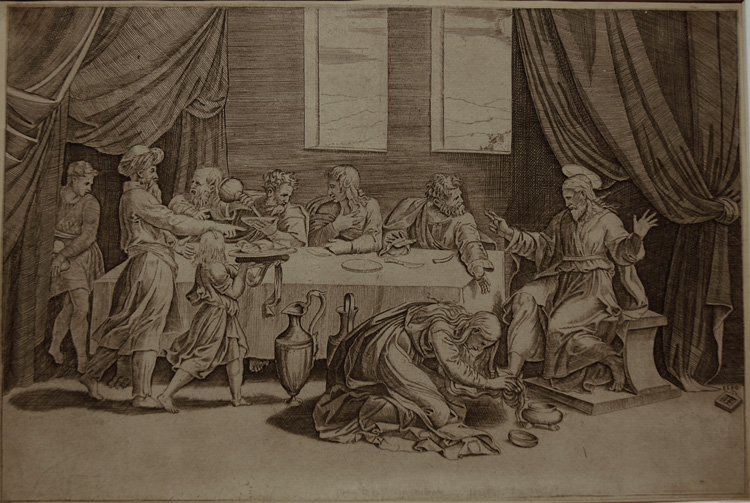
Giacomo Francia (Bologna, 1486-1557), Mary Magdalen repenting. Original engraving, 1530. Printed on laid paper and mounted upon a support sheet. Trimmed on or inside of the platemark. Small spot in draperies upper left. Two pinprick-sized holes in draperies upper right. Dated "1530" and signed "IF" [Iacomo Francia] in the cartouche at right beneath the bottom of the drapes. Francia was a painter, engraver, and goldsmith. He and his brother succeeded his father as the heads of a thriving workshop that painted many commisions for altarpieces in and around Bologna from 1517 to their deaths. Arthur M. Hind, Early Italian Engraving (London: 1938-48) attributes 19 engravings to Jacopo, four of which are illustrated in Jay A. Levinson, Konrad Oberhuber, and Jacquelyn L. Sheehan, Early Italian Engravings from the National Gallery of Art (Washington DC: National Gallery of Art, 1973), 492-501. Sheehan usefully reminds us that Marcantonio Raimondi also studied with Francisco Franco, so that his and Giacomo's early works are likely to be stylistically similar. Marcia Pointon's entry in the Grove Dictionary of Art (Oxford University Press, 1996), 11: 702-703, suggests that in addition to the early training Giacomo received from his father, Francesco, he was also influenced by Raphael and Parmigianino. Our impression is printed in brownish-black ink amd appears to be an early one. Very rare! Image size: 242x343mm. Price: Please call or email for current pricing information.
The events are narrated in Luke 7:37ff: "And, behold, a woman in the city, which was a sinner, when she knew that Jesus sat at meat in the Pharisee’s house, brought an alabaster box of ointment, And stood at his feet behind him weeping, and began to wash his feet with tears, and did wipe them with the hairs of her head, and kissed his feet, and anointed them with the ointment. Now when the Pharisee which had bidden him saw it, he spake within himself, saying, 'This man, if he were a prophet, would have known who and what manner of woman this is that toucheth him: for she is a sinner.' And Jesus answering said unto him, 'Simon, I have somewhat to say unto thee.' And he saith, 'Master, say on.' 'There was a certain creditor which had two debtors: the one owed five hundred pence, and the other fifty. And when they had nothing to pay, he frankly forgave them both. Tell me therefore, which of them will love him most?' Simon answered and said, 'I suppose that he, to whom he forgave most.' And he said unto him, 'Thou hast rightly judged.'And he turned to the woman, and said unto 'Simon, Seest thou this woman? I entered into thine house, thou gavest me no water for my feet: but she hath washed my feet with tears, and wiped them with the hairs of her head. Thou gavest me no kiss: but this woman since the time I came in hath not ceased to kiss my feet. My head with oil thou didst not anoint: but this woman hath anointed my feet with ointment. Wherefore I say unto thee, Her sins, which are many, are forgiven; for she loved much: but to whom little is forgiven, the same loveth little.' And he said unto her, 'Thy sins are forgiven.' And they that sat at meat with him began to say within themselves, 'Who is this that forgiveth sins also?' And he said to the woman, 'Thy faith hath saved thee; go in peace.' "

Jan Sadeler (Dutch, c. 1550-1600), attributed. Mary Magdalen in the House of Simon the Leper. Engraving, c. 1582. This is in the format of engravings that Sadeler executed for the Plantin Bible (1583). According to the text at the bottom left, this depicts not the episode in Luke, but that of Matthew 26: 6-13: "Now while Jesus was at Bethany in the house of Simon the leper, a woman came to him with an alabaster jar of very costly ointment, and she poured it on his head as he sat at the table. But when the disciples saw it, they were angry and said, 'Why this waste? For this ointment could have been sold for a large sum, and the money given to the poor.' But Jesus, aware of this, said to them, 'Why do you trouble the woman? She has performed a good service for me. For you always have the poor with you, but you will not always have me. By pouring this ointment on my body she has prepared me for burial. Truly I tell you, wherever this good news is proclaimed in the whole world, what she has done will be told in remembrance of her.' " On the reverse there is another engraving showing the separation of the sheep and the goats at the Last Judgment. Image size: 169x117mm. Price: Please call or email for current pricing information.

Jan Saenredam (Dutch, c. 1565-1607), Women of the New Testament: Mary Magdalen (Bartsch 45). Engraving after Hendrik Goltzius. Signed in the plate top right: "HGoltzius inuent. I Saendredam sculp"; numbered 2 lower left above inscription. Ours is a very good but later impression published by G. Valck (1626-1720) and with his name inscribed bottom center in the inscription. Trimmed outside the platemark. This was part of a set formerly owned by the Philadelphia Museum of Art. Image size: 189x135mm. Price: Please call or email for current pricing information.

Carel de Mallery (Antwerp, 1566-1628), Maria Magdalena (H. Collaert, Hol. 33-46ii, with the Biblical citation to Luke 7:17). Engraving after Maarten de Vos, c. 1597. Plate 11 from a set of Icones Illustrum Feminarium Novi Testamenti / Images of Celebrated Women of the New Testament" consisting of 15 engravings (plus frontispiece) by Jan II or Adrien Collaert or Carel de Mallery published in Antwerp by Jan Galle. Image size: 154x94mm. Price: Please call or email for current pricing information.
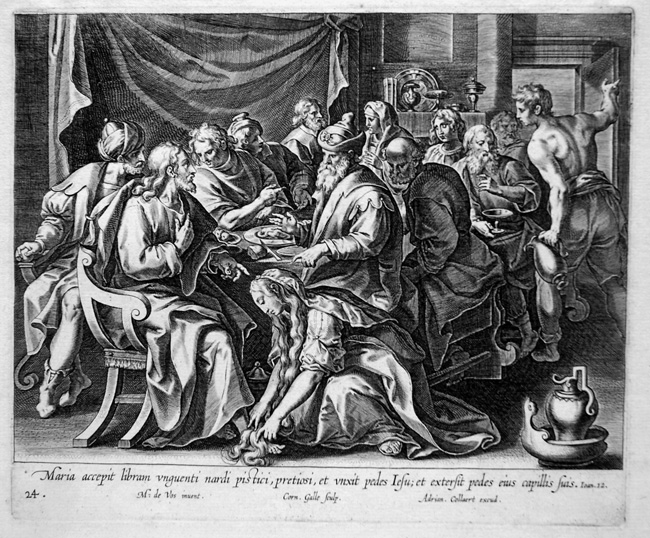
Cornelis Galle I (Antwerp, 1576-1650), Mary Magdalen annointing Christ's feet (New Hollstein de Vos 298 ii/iii). Engraving after Maarten de Vos, c. 1597. Plate 24 of a series of 51 engravings on The Life, Passion and Resurrection of Christ. Our impression is from the second state (with the number 24) published in Antwerp in by Adrien Collaert (Antwerp, c. 1560-1618). The series was very popular and printed five times by itself, of which Adrien Collaert's was the first edition, and was used as well in other series, including the Theatricum Biblicum (1643). Cornelis Galle I was the son of Philips Galle and Adrien Collaert was his son-in-law. The third and fourth editions were published by another of Philips Galle's sons, Theodore, and the final edition was published by Theodore Galle's widow. This suggests that the print publishing business in Antwerp was controlled by a very small number of artist-publishers and their families. Ours is a very good impression with wide margins in very fresh condition. Image size: 182x217mm. Price: Please call or email for current pricing information.

Albrecht Durer (Nuremburg, 1471-1528), The Crucifixion (B. 40, S. 124) Original woodcut, c. 1509 for the Small Passion. Strauss observes that Dürer "has relegated St. John to a place in the background, behind the group of the Holy Women. He concentrates on the figure of the Magdalen, in the foregound, on her knees, who symboliizes extreme grief in a stance that is imediately comprehensible to the widest possible audience" (Walter L. Strauss, Albrecht Durer Woodcuts and Woodblocks [Abaris Books, 1980], p. 378). A good 16th-century impression without text after the first edition with margins outside the border. The block has been chipped in the lower left corner and at the top border at left and center. Some wear, but still printing darkly. Image size: 127x97mm. Price: Please call or email for current pricing information.

Georg Pencz (German, 1500-1550), Christ on the Cross (Bartsch 57). Original engraving, 1547. A very good impression on laid paper with small margins around the platemark. Signed in the plate with the monogram and dated. Pencz is one of the most important "little masters," the generation of German printmakers who were strongly influenced by Albrecht Durer and who tended to work in very small sizes. Image size: 115x80mm. Price: Please call or email for current pricing information.

Cornelis Cort (Netherlandish, 1533-1578), The Crucifixion (New Hollstein 63 ii/iii; Clovio p. 89). Engraving after Giulio Clovio (1478-1578), 1566. Published in Rome by Antonio Lafrery (1512-c.1580). A very good impression trimmed on or within the platemark. After spending several years in Italy (including time in Titian's workshop and in Rome), he returned to the Netherlands and helped introduce Italian Mannerism to the north where he became one of the leading Mannerist engravers working in the Netherlands during the formative years of the Antwerp School. Vasari called Clovio the "new and little Michelangelo." Image size: 348x253mm. Price: Please call or email for current pricing information.
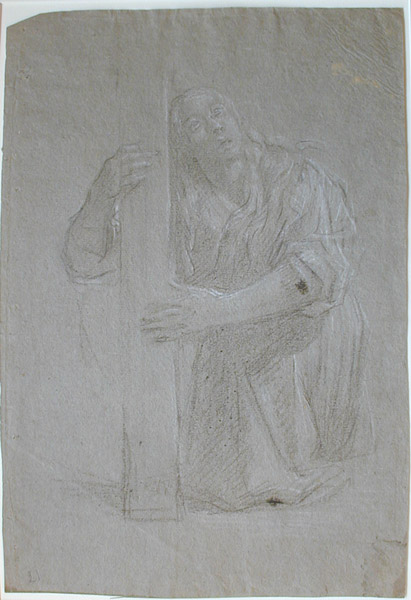
Etienne Parrocel called "Le Romain" (French, 1696-1776), Mary Magdalen Embracing the Cross. Black & white chalk drawing on bluish green laid paper. Possibly a study in connection with the decoration of the dome of the Church of the Magdalen in Rome. In the past 15 years, 46 of his works have sold at auction, of which 28 were drawings; the high price for a black-and white chalk drawing was Please call or email for current pricing information 750; for a drawing: Please call or email for current pricing information 310. Parrocel's father and uncle were also painters. In 1717, he accompanied his uncle Pierre to Rome and settled down there, becoming a member of the Academie de Saint-Luc (the patron saint of painters). He received commissions for paintings at the Churchs of Sainte-Marie and Saint-Louis des Francais in Rome as well as commissions for numerous portraits of the holy family, cardinals, and saints. Image size: 413x281mm. Price: Please call or email for current pricing information.

Flemish School, 17th Century, Penitent Magdalene. Red chalk on laid paper with no watermark. The general influence of Rubens is clear, though not the specific artist trying to work in Ruben's style. Image size: 430x315mm. Price: Please call or email for current pricing information.

Carel de Mallery (Antwerp, 1566-1628), Maria Salome (H. Collaert, Hol. 33-46i/iii, with the Biblical citation). Engraving after Maarten de Vos, c. 1597. Plate 13 from a set of Icones Illustrum Feminarium Novi Testamenti / Images of Celebrated Women of the New Testament" consisting of 15 engravings (plus frontispiece) by Jan II or Adrien Collaert or Carel de Mallery published in Antwerp by Philips Galle. Mark 16:2-14: "And when the sabbath was past, Mary Magdalene, and Mary the mother of James, and Salome, had bought sweet spices, that they might come and anoint him. And very early in the morning the first day of the week, they came unto the sepulchre at the rising of the sun. . . . And entering into the sepulchre, they saw a young man sitting on the right side, clothed in a long white garment; and they were affrighted. And he saith unto them, 'Be not affrighted: Ye seek Jesus of Nazareth, which was crucified: he is risen; he is not here: behold the place where they laid him. But go your way, tell his disciples and Peter that he goeth before you into Galilee: there shall ye see him, as he said unto you.' And they went out quickly, and fled from the sepulchre; for they trembled and were amazed: neither said they any thing to any man; for they were afraid. Now when Jesus was risen early the first day of the week, he appeared first to Mary Magdalene, out of whom he had cast seven devils. And she went and told them that had been with him, as they mourned and wept. And they, when they had heard that he was alive, and had been seen of her, believed not. After that he appeared in another form unto two of them, as they walked, and went into the country. And they went and told it unto the residue: neither believed they them. Afterward he appeared unto the eleven as they sat at meat, and upbraided them with their unbelief and hardness of heart, because they believed not them which had seen him after he was risen. " Image size: 154x94mm. Price: Please call or email for current pricing information.
For the encounter between Jesus and Mary Magdalen after Christ's resurrection, please click here.
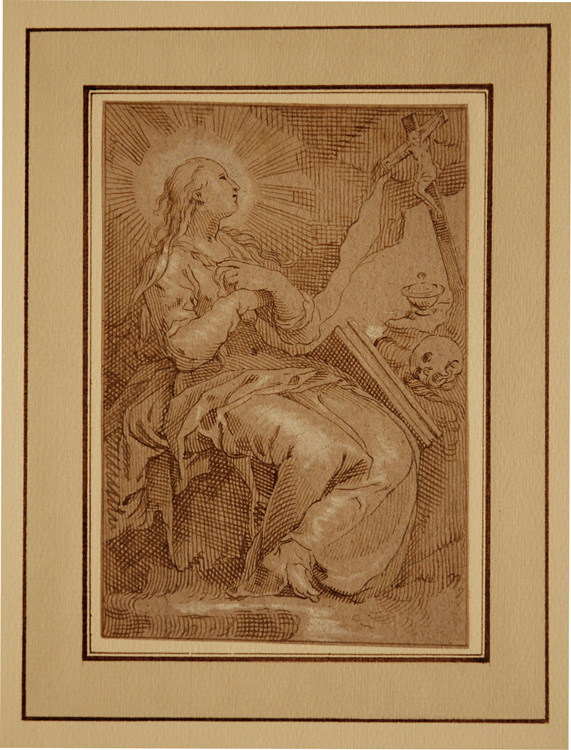
Abraham Bloemaert (Dutch, 1566-1651), attributed to), The Penitent Magdalene. Pen and brown ink heightened with white on gray paper, early 17th c. A beautifully executed drawing. By the beginning of the 17th century, Bloemaert was the leading master in Utrecht. He was a prolific draftsman who executed over 1500 drawings, many of which served as models for prints. Image size: 130x90mm. Price: Please call or email for current pricing information.

Lucas van Leyden (Dutch, 1494-1533), Mary Magdalen in the Desert (Bartsch 123, New Hollstein 123b). Original engraving, c. 1506. Signed with the "L" bottom center. Later impression on laid paper, thread margins except at right; trimmed outside the border. Image size: 112x88mm. Price: Please call or email for current pricing information.
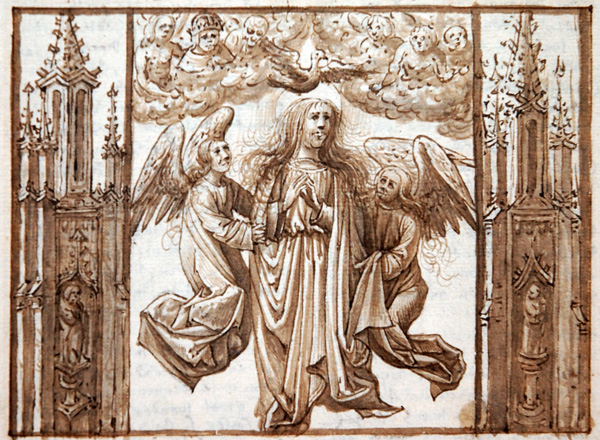
Dutch School (late 15th-early 16th century, Mary Magdalen raised to heaven by angels. Pen and wash. This is a leaf from a manuscrupt book of Saints' Lives (possibly the Legenda Aurea or Golden Legend) commissioned by someone conservative enough not to trust such newfangled inventions as printing presses (clearly they will never last), wealthy enough to pay for a hand-made written and illustrated book, and desirous of something inspirational: the two leaves we have both feature sinners rescued by divine intervention. According to the Golden Legend, after "St. Mary Magdalen" had moved to France and by preaching had prepared the citizens of Marseilles and Aix to convert to Christianity, "moved by her wish to live in contemplation of the things of God, [she] retired to a mountain cave which the hands of angels had made ready for her, and there she dwelt for thirty years. . . . There she found neither water nor herb nor tree, whereby she knew that Jesus wished to sustain her with naught but heavenly meats, allowing her no earthly satisfaction. But every day the angels bore her aloft at the seven canonical hours, and with her bodily ears she heard the glorious chants of the heavenly hosts. Then, being filled with this delightful repast, she came down to her grotto, and needed no bodily food" The Golden Legend of Jacobus de Voraigne, trans. and adapted Granger Ryan and Helmut Ripperger (NY: Arno Press, 1969, pp. 360-61). Image size:120x143mm. Price: Please call or email for current pricing information.
